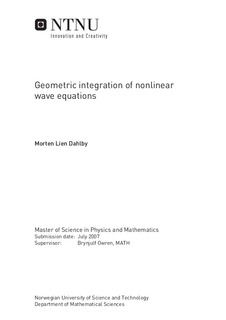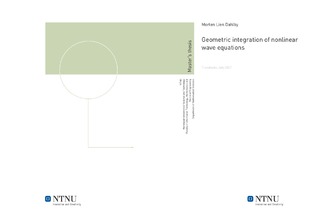| dc.contributor.advisor | Owren, Brynjulf | nb_NO |
| dc.contributor.author | Dahlby, Morten Lien | nb_NO |
| dc.date.accessioned | 2014-12-19T13:58:32Z | |
| dc.date.available | 2014-12-19T13:58:32Z | |
| dc.date.created | 2010-09-13 | nb_NO |
| dc.date.issued | 2007 | nb_NO |
| dc.identifier | 351333 | nb_NO |
| dc.identifier | ntnudaim:3434 | nb_NO |
| dc.identifier.uri | http://hdl.handle.net/11250/258702 | |
| dc.description.abstract | We give an short introduction to the Camassa-Holm equation and its travelling wave solutions. Many well-known equations in mathematical physics describe geodesic flows on appropriate Lie groups. The choice of group and metric defines the Euler equation. We show that by choosing the group of diffeomorphisms on the circle and the Sobolev H^1-metric one gets the Camassa-Holm equation. The equation is shown to have a bi-Hamiltonian structure, and thus infinitely many conserved quantities. We introduce a new class of methods that can be applied to the Euler equation. We solve the Camassa-Holm equation by freezing some of the coefficients in the Euler equation and applying a Lie group integrator. In some situations the method is found to outperform existing schemes. The available numerical methods is reviewed and modified. We compare long term structure preservation for both smooth and non-smooth initial conditions for each method. Of special interest is the ability to handle wave collisions. | nb_NO |
| dc.language | eng | nb_NO |
| dc.publisher | Institutt for matematiske fag | nb_NO |
| dc.subject | ntnudaim | no_NO |
| dc.subject | SIF3 fysikk og matematikk | no_NO |
| dc.subject | Industriell matematikk | no_NO |
| dc.title | Geometric integration of nonlinear wave equations | nb_NO |
| dc.type | Master thesis | nb_NO |
| dc.source.pagenumber | 56 | nb_NO |
| dc.contributor.department | Norges teknisk-naturvitenskapelige universitet, Fakultet for informasjonsteknologi, matematikk og elektroteknikk, Institutt for matematiske fag | nb_NO |

